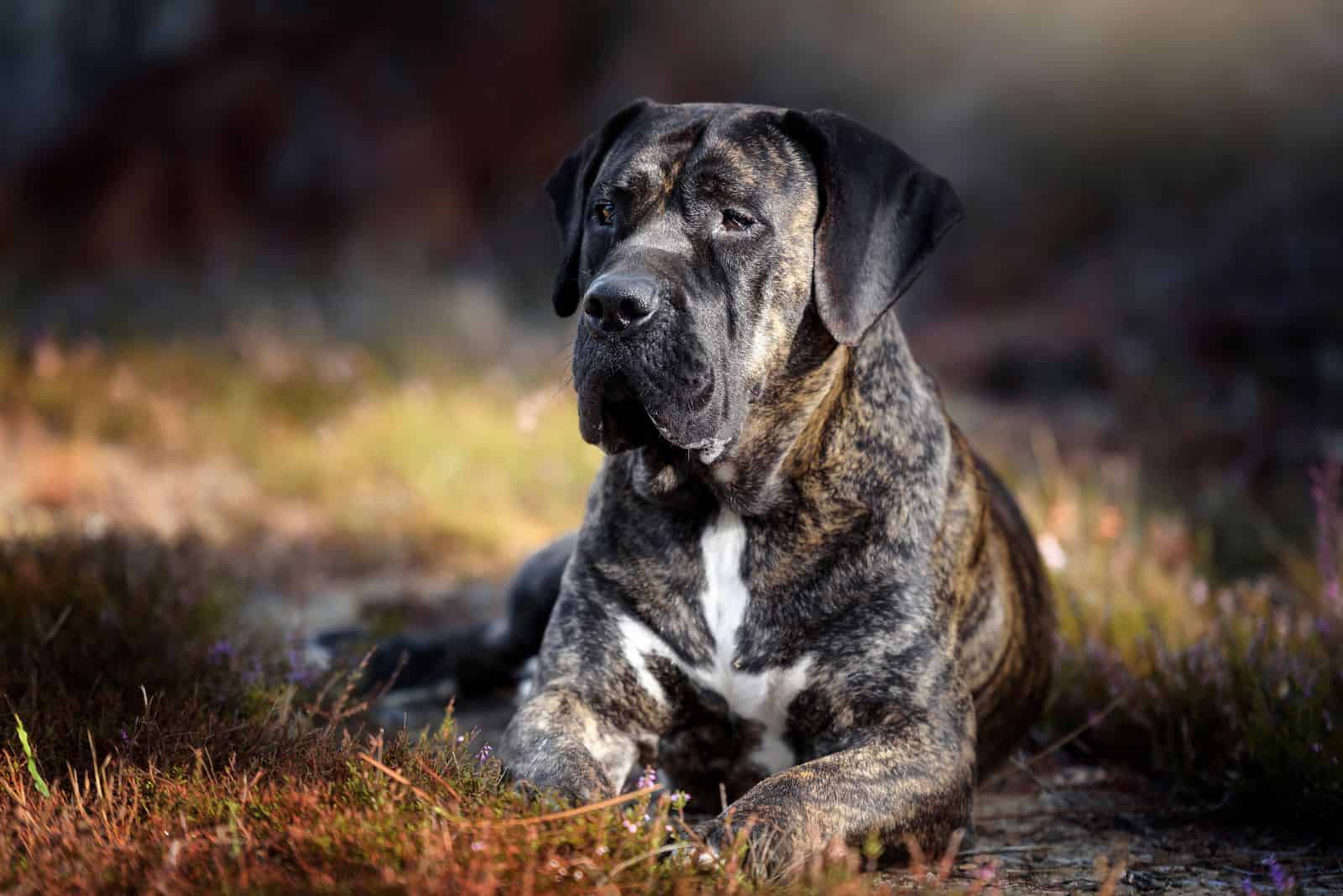Perro de Presa Canario colors are just as exotic as the origin of this dog. So, let’s trace the footsteps of our molossoid pup to the sandy beaches of the Canary Islands and get to know him a little bit better.
Some say he came along with Spanish conquistadores, and he was developing there until he got the form he has today. Others say that the influence of British arrivals also had a great impact on this dog.
One thing is sure – they are so proud of their dog in the Canary Islands that they made him one of their national symbols. But, his past isn’t so glamorous.
Since this pooch is bulky, big, and considered a dangerous dog, he was mostly used as a catch dog. He had to earn himself a dinner, and he had to work hard for it.
And, a dog like this was a real treasure for dog owners back then. He is the perfect guard dog that can do herding tasks just as well.
And, some would even use him for dog fights, which is illegal today.
In one moment, this dog almost went extinct, but with the efforts of some dog lovers and enthusiasts, they managed to save him. Today, with the help of foundation stock service, this rare breed can continue to develop without fear of extinction.
This native Canarian is most popular in the island of Tenerife and in Gran Canaria.
Now, let’s see which kind of coat this pooch needs in order to look good in all these sandy beaches and breathtaking exotic sights. Let’s get to know Presa Canario colors a little bit better.
If you live in America, you can find the best Presa Canario breeders in the U.S.
Perro De Presa Canario Colors
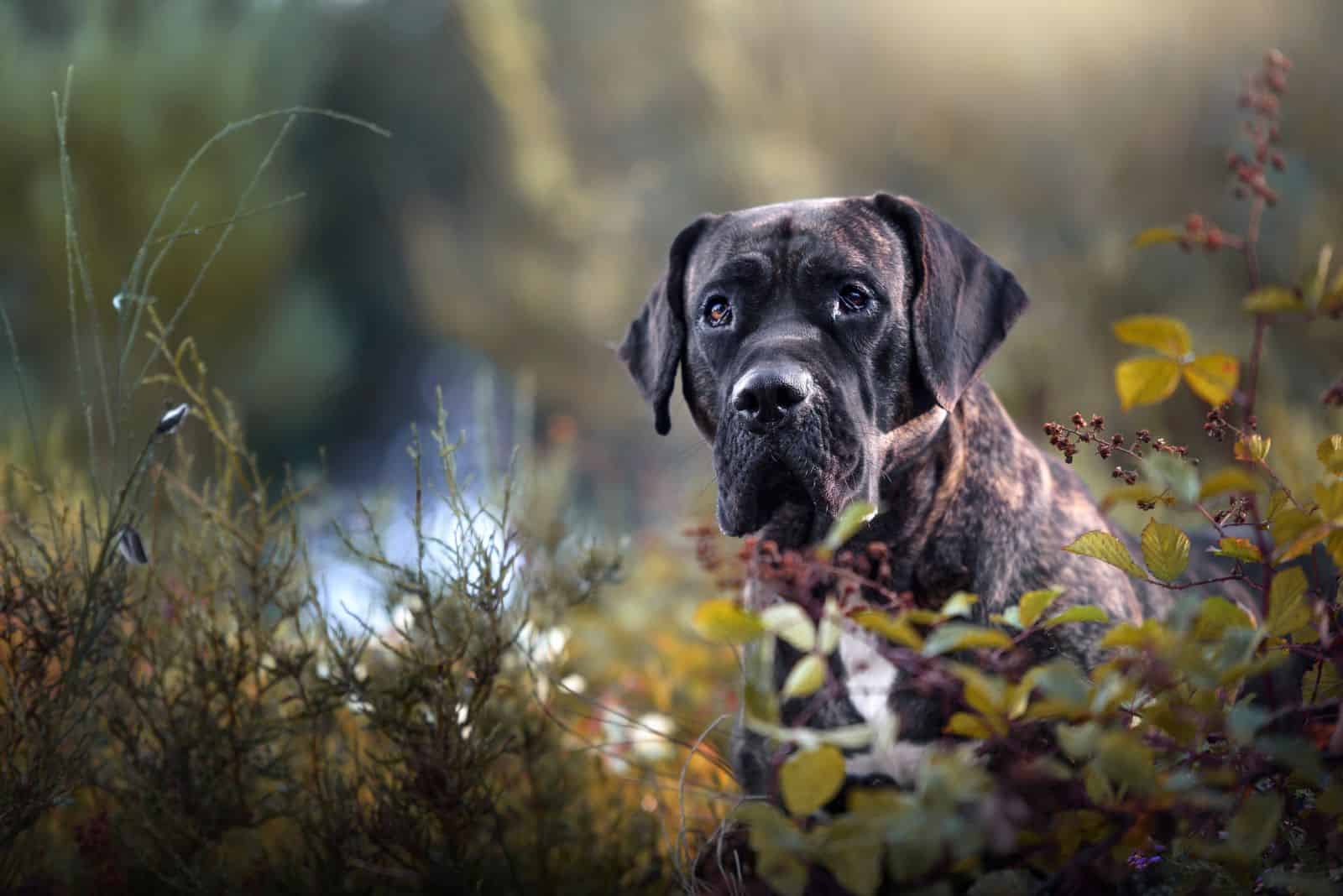
Dog colors are really an endless theme that can be discussed in detail. That is what makes our little and big friends so special.
Today, dog colors are an important factor when it comes to choosing a dog.
The Perro de Presa Canario colors have a standard that is prescribed by some official breed clubs.
Even though, in my opinion, dogs are beautiful in all their shapes, sizes, and colors, having a breed standard is important.
A fair competition in conformation shows would not be possible if there was no standard.
Also, standard colors help us to distinguish reputable breeders from those who are not very responsible.
But, when it comes to the Presa Canario breed, there are a few fallouts between what is considered as a standard in kennel clubs.
This bearlike dog has made some real fuss among kennel clubs, so the universal standard was not uniformed until this day.
Under the Federation Cynologique Internationale (FCI), Presa Canario dogs are registered under the No 346 as a Molossoid breed of the Mastiff type. It is considered a strong, working dog that is very loyal.
But, the FCI does not have exactly the same standards for this Canary dog as the UKC, the AKC, and the UPPCC have.
Perro De Presa Canario Colors And Markings Chart
We will follow the instructions of the AKC breed standard here, and in the sequel under, we will quote registered colors and markings.
The UKC Presa Canario breed standard is similar to the one that the AKC has, but it has one difference.
Recognized Colors Markings
Brown White Markings
Fawn Brindle Markings
Gold
Orange
Silver
Tiger
A Few Words On Markings
When it comes to markings, there are certain things that are allowed and some things that are not allowed.
White markings are allowed, but there shouldn’t be too many of them. This means a minimum of white strictly on the areas of the chest, on the toes, both on the back feet, and on the forefeet.
The markings on the toes should be minimal. It is also allowed to have white markings on the neck and throat.
When it comes to the black mask, it can blaze, but it is not necessary. The only condition is that this mask does not go over the eye level.
The black mask makes our dog look like he should be placed on the list of dangerous dogs, which he can be.
What Is Not Allowed?
If there is no black mask at all, that is considered as a disqualification. Also if the black mask extends over the eye level, it is considered as a fault. That makes the Presa Canario look aggressive.
When the nose has no pigment at all, it is also considered to be a fault.
White markings are allowed, but minimally. This means they should be present in less than 20% of full body coverage.
When it comes to colors, all the colors that are in the chart are allowed. Anything that isn’t in the chart is considered as a fault, and indicates that the dog is not a purebred.
What Are The Differences Between Standards?
When we talk about the AKC color standard, we talk about brown, fawn, gold, orange, silver, and tiger color, as well as white markings and brindle markings.
The UKC standard states that the Perro de Presa Canario can have fawn and brindle in all shades. They add the color, black, as a standard, which is something we can find in the AKC and the FCI.
They also state that when it comes to markings, what is allowed are white markings and a black mask. However, a black mask isn’t stated with the AKC.
When it comes to the FCI standard, we have stated that brindle is allowed in all shades. This includes tones from blond and gray to dark brown.
They allow fawn in all shades, as well as sandy in all shades. They also allow white markings and a black mask.
Are All Presa Canarios Brindle?
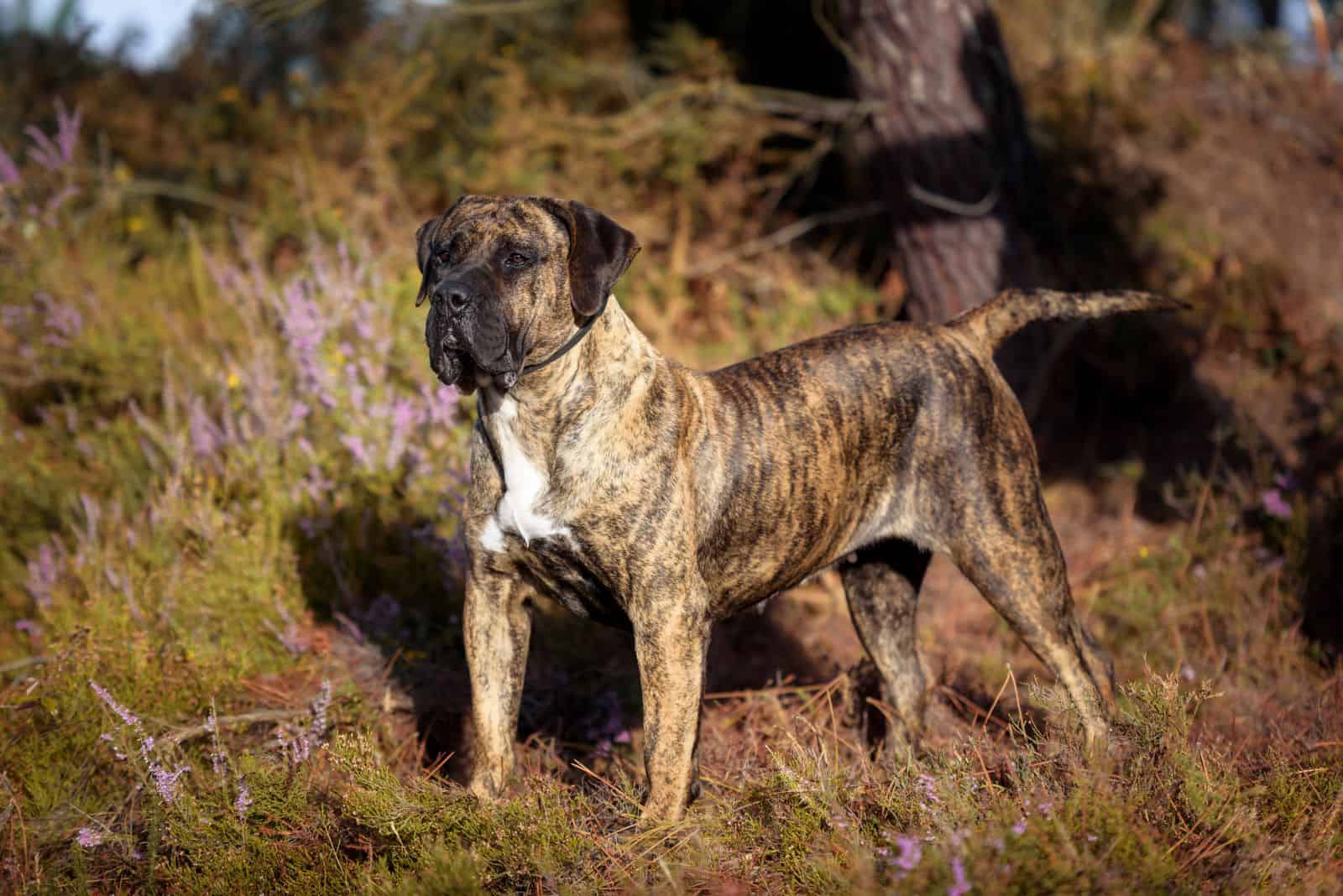
When we mention Presa Canario colors, the first question that many people ask sounds like this: Are all Presa Canarios brindle?
But, it is an incorrectly placed question, actually. The thing is that brindle is not a solid color, and by the American Kennel Club, it is actually a marking.
So, when we talk about brindles, we talk about patterns of color that draw over basic color. It modifies a foundation so the final result looks like what you typically see in a Presa Canario.
This result is conditioned by genetics like any other trait that is unchangeable.
Fawn, brown, gold, silver, orange, tiger… those are all fine colors, and actually, they are recognized and considered as colors. But, this combination that we colloquially call brindle is most popular.
This color is uniquely connected to the Presa Canario, and it adds to his menacing looks and reputation of a scary dog breed.
When we talk about brindles, it is like we are talking about fingerprints. There are so many variations that one might think that every variation is unique to the dog that carries it.
We talk about the full spectrum of colors, shades, and colored stripes here. These stripes are what gives uniqueness to the coat color.
The Specialty Of Brindle
Foundation color ranges from light fawn to dark brown, with many in-between variations that include red fawn, light gray, all shades of blonde, and all shades of orange, particularly intense.
When we talk about stripes, they are always deep and dark – black, to be precise. And, these stripes make unique patterns that give the animal that special combination of colors.
Brindle can also be reversed, but only in appearance. In reality, it is again a foundation color, and black stripes. But, what am I talking about?
When there are so many black stripes, they are so dense that it appears that the dog is black and that the stripes are goldish. That is because the base color appears only occasionally on the coat.
Genetic Background Of The Brindle Color
When we talk about inheriting a particular trait, we must know something about the rules of inheritance. So, let’s discuss how we get a dog that appears brindle.
If you want to produce a brindle puppy, the easiest way is to find two parent dogs that already express these traits. To express a trait means that one can see it. For example, a dog is brindle colored.
But, even that is not a guarantee that a puppy will have that kind of color. This is because we have dominant and recessive genes in every gene carrier.
One must inherit either both dominant genes or dominant and recessive genes to express certain traits – in this case, it is the brindle color.
If he inherits both recessive genes, then the trait won’t be expressed.
So, in this case, the way to inherit the brindle color is to have both brindle-colored parents.
Another way is to pair brindle and fawn parents or brindle black and fawn black parents.
You can’t get a brindle dog out of two fawn-colored parents because fawn is a recessive trait, and this means that these parents are not carriers of the dominant brindle gene. And, if there is no gene for some trait, it can’t be expressed.
Brindle Genetic Combinations
Do you know what homozygous and heterozygous are? Homozygous beings carry a certain gene that has two identical alleles. For example, both alleles produce a brindle color in a dog, which means that both are dominant.
Heterozygous beings have a gene that has two different alleles. For example one allele produces a brindle color, while the other produces a fawn color.
The allele for brindle is dominant, while the allele for fawn is recessive. This means that a combination of these two will make a brindle dog unless two recessive alleles combine with each other.
Let’s see some combinations that can be produced by mixing certain genes.
If we have a dog that is genetically heterozygous with a brindle gene combined with a dog that is fawn colored, we will get brindle and fawn puppies in the litter.
If we have a dog that is genetically homozygous with a brindle gene combined with a dog that is fawn colored, we will just get brindle puppies in the litter.
So, to repeat – when we have brindles that are heterozygous, we will get puppies that can be heterozygous and homozygous, and in brindle or fawn.
When we have brindles that are homozygous, we get only homozygous brindles.
When we have brindles that are heterozygous and homozygous, we will get puppies that are brindle, but there is still a possibility for them to be the carriers of the fawn gene that can be expressed in the future.
So, when we talk about Presa Canario colors, most of the talk goes on the brindle, but there are other beautiful colors to talk about.
What Is A Verdino?
When we talk of alter egos, the Presa Canario has many. Some call him Dogo Canario, others call him Canary Mastiff. That is why you can find him in combination with many Mastiff mixes. There is also a Perro Basto, which is a rough dog, and a Podenco, which is a fine dog.
But, there is an old name that this intimidating dog breed is also known under.
Traditionally, he was named as a Gripping Dog or a Gripper as well as a Verdino Dog.
But, what is a Verdino? We can easily say that it is one of the many names for the Presa, but what does it refer to?
Verdino literally means ‘greenish’ in the languages of Latin origin. There is a similar term, ‘bardino’, which refers to Bardino Majorero, but those terms are not the same.
The greenish color is a product of bardino – white and fawn. It is called this way because coats of this type have a kind of green reflection.
It kinda makes him look like a Pitbull, to be honest.
But, this term is also used to describe any shade of brindle, so it is basically a synonym for brindle.
The term is widespread in Tenerife, in the shape of Perro Verdino.
Is Solid Black A Presa Canario Color?
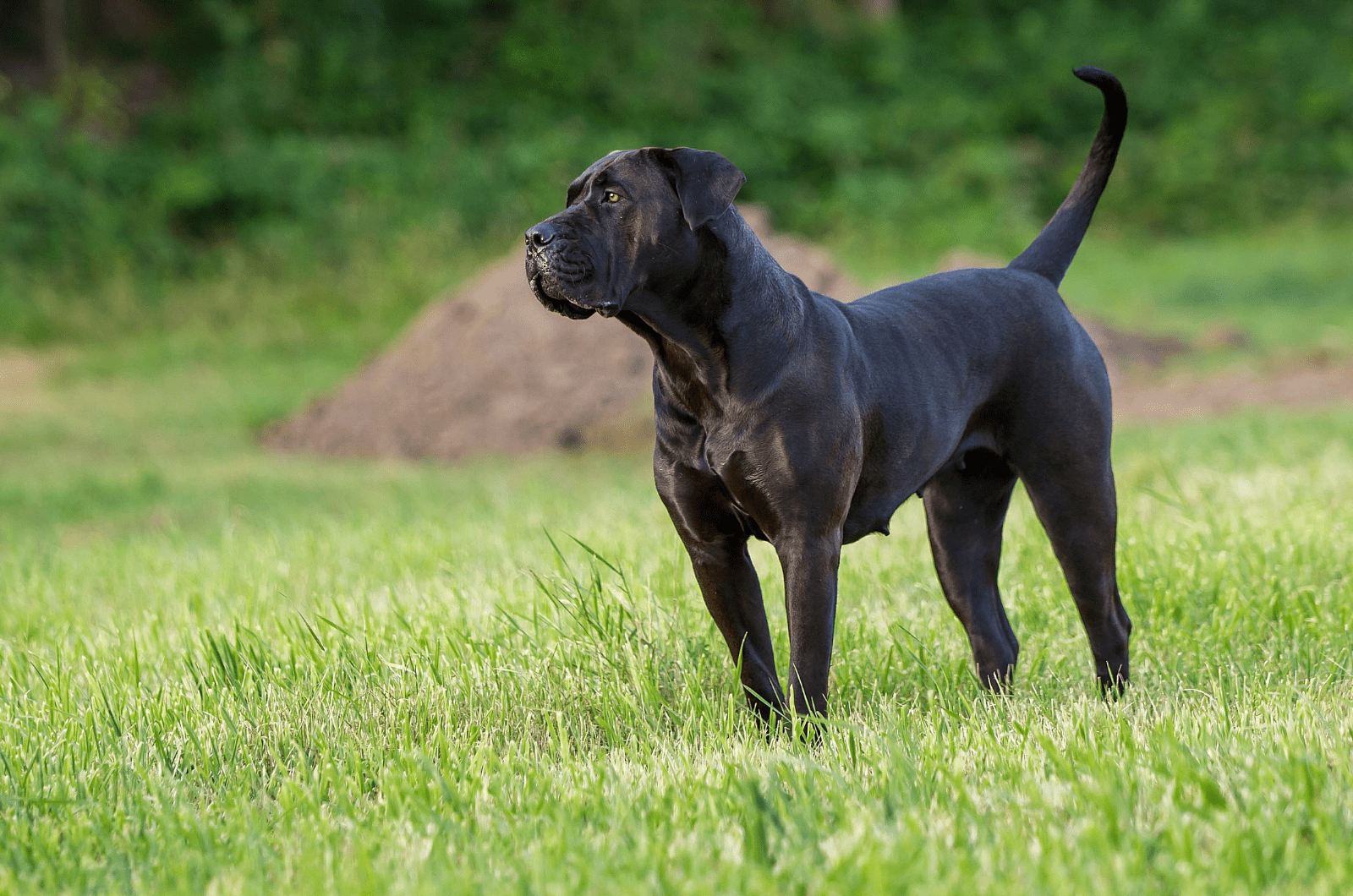
The short answer is no. The long answer is also no.
We have already mentioned that there are colors that are considered a breed standard, and they don’t include black unless it is in the form of a mask or as a striped pattern over the body.
Solid colors are not preferable in a Presa Canario at all. Solid white is not acceptable, and is considered a fault. The same is with black.
Solid black color is an undesirable trait, and it indicates the wrong breeding process. What is especially undesirable is black that is glossy. That means it is shiny in the manner of a mirror.
The color black has a psychological effect on many people. We usually associate black color with some negative traits like death, illness, depression, and bad luck.
There are some studies that say that people tend to perceive black dogs as being more dangerous and aggressive, and as bad luck.
And, if we add a menacing look and the reputation such as a Presa Canario has, the effect is double.
But, this interesting fact has nothing to do with the choice of standard colors of these Molosser type dogs.
It only has to do with genetics and what experts thought a proper Presa Canario should look like.
What Color Is A Presa Canario Puppy?
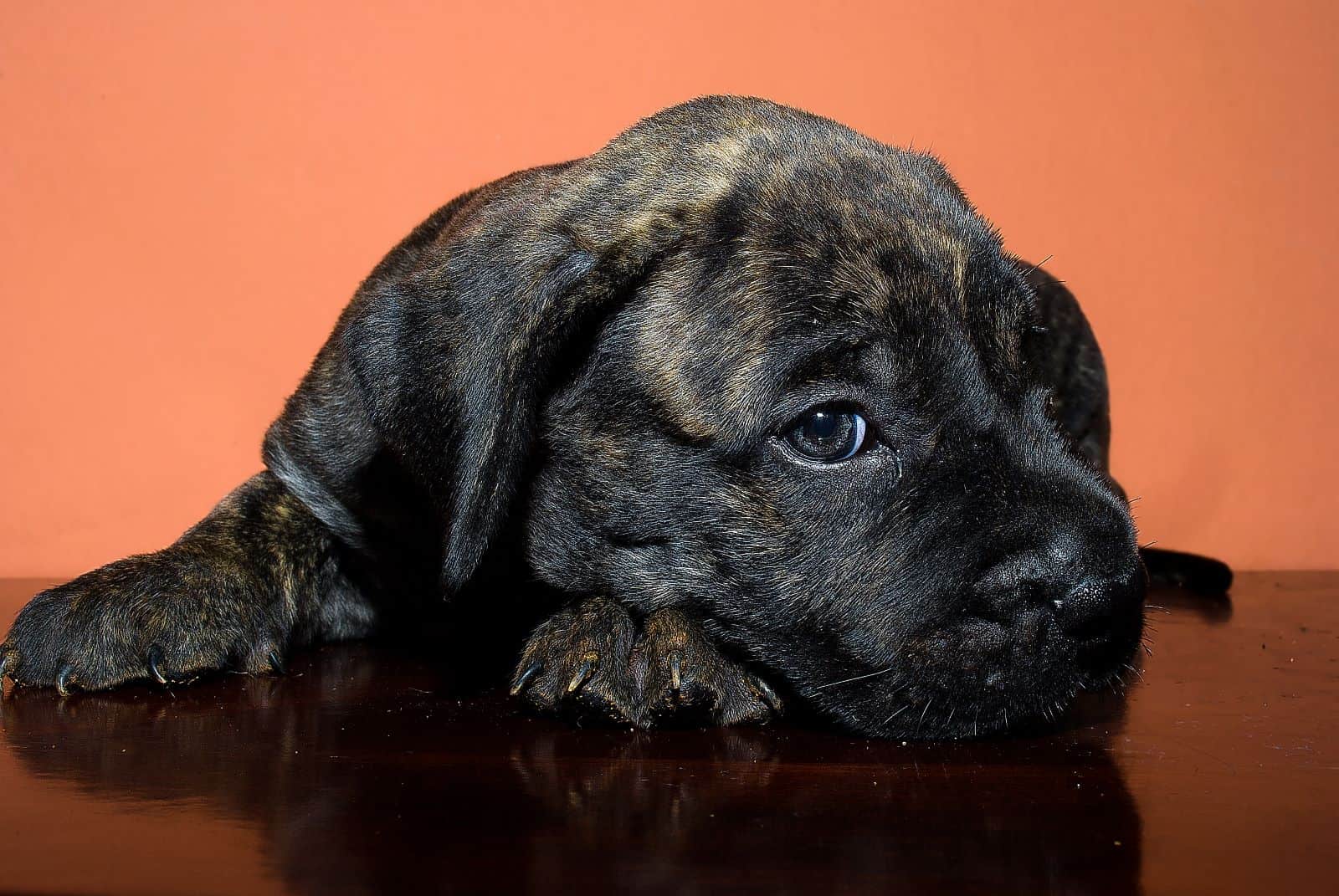
Just imagine a small Presa Canario. Are you able to do so? It is hard to think of such a huge guard dog as a small puppy, to be honest.
If we ask the Perro de Presa Canario breeders to describe this dog, they would probably say that they are adorable family dogs.
I bet that they fall in love with the puppy version of this impressive breed, and remain looking at him with those eyes.
And, it is no wonder since these dogs don’t change much. The color they have as an adult is the same color they were born with.
So, if your puppy is born brindle, then he will be brindle as an adult. If the puppy was born fawn, then he will remain fawn as an adult.
Any shade in between like grayish or blonde, or goldish and orange will remain the same when the puppy grows up.
So, these puppies come into this world colored in any Presa Canario color that their genetics provide them. The only difference is that they go from being super cute to super impressive.
Historical Aspect And Perro De Presa Canario Colors
You might confuse a Presa Canario with a Cane Corso. That is not a surprise because both of them are mighty dogs that many perceive as intimidating.
Both of them have really strong bites, and they provide us with a really awesome Presa Canario Cane Corso mix.
The history of the mighty dogs is always interesting because it is full of danger, difficult tasks, and mystery. Many mighty dogs come from exotic places like Pakistan, India, and some Mediterranean places, even England.
When we think of dangerous dogs, we usually remember Bulldogs, German Shepherds, Mastiffs, and other common breeds.
There are many dogs that originate from Spain, and that have a similar reputation. For example, the Alano Espanol, the Perro Majojero, and our Perro de Presa Canario.
Historical Role Of The Colors
When we take a leap back on the history line of our Presa Canario’s development, we will find ourselves in the middle of some big Spanish property that had to be defended from intruders, and where people worked very hard jobs.
So, they needed every possible form of help, and often, that help was in canine form. Many dog breeds are able to do a lot of tasks, and they do them better than humans.
Just remember sheepdogs or cattle dogs, or some northern, thick undercoat dogs that pull sleds that are able to live in a cold environment, or dogs that pull carts.
So, back in the past, the color of the dog was not a factor of huge impact. What was important was that the dog was healthy and had a long lifespan.
Health means avoiding health issues. Common health problems for dogs such as the Presa Canario are epilepsy, and hip and elbow dysplasia.
The traits that were important for the breeders back then were those that would make dogs endurable and capable of doing tasks, which would make them dangerous so the property would be safe. Color was the last thing that was important.
Unlike today, when dogs have different roles in society, color is more important.
Wrapping Up On The Perro De Presa Canario Colors
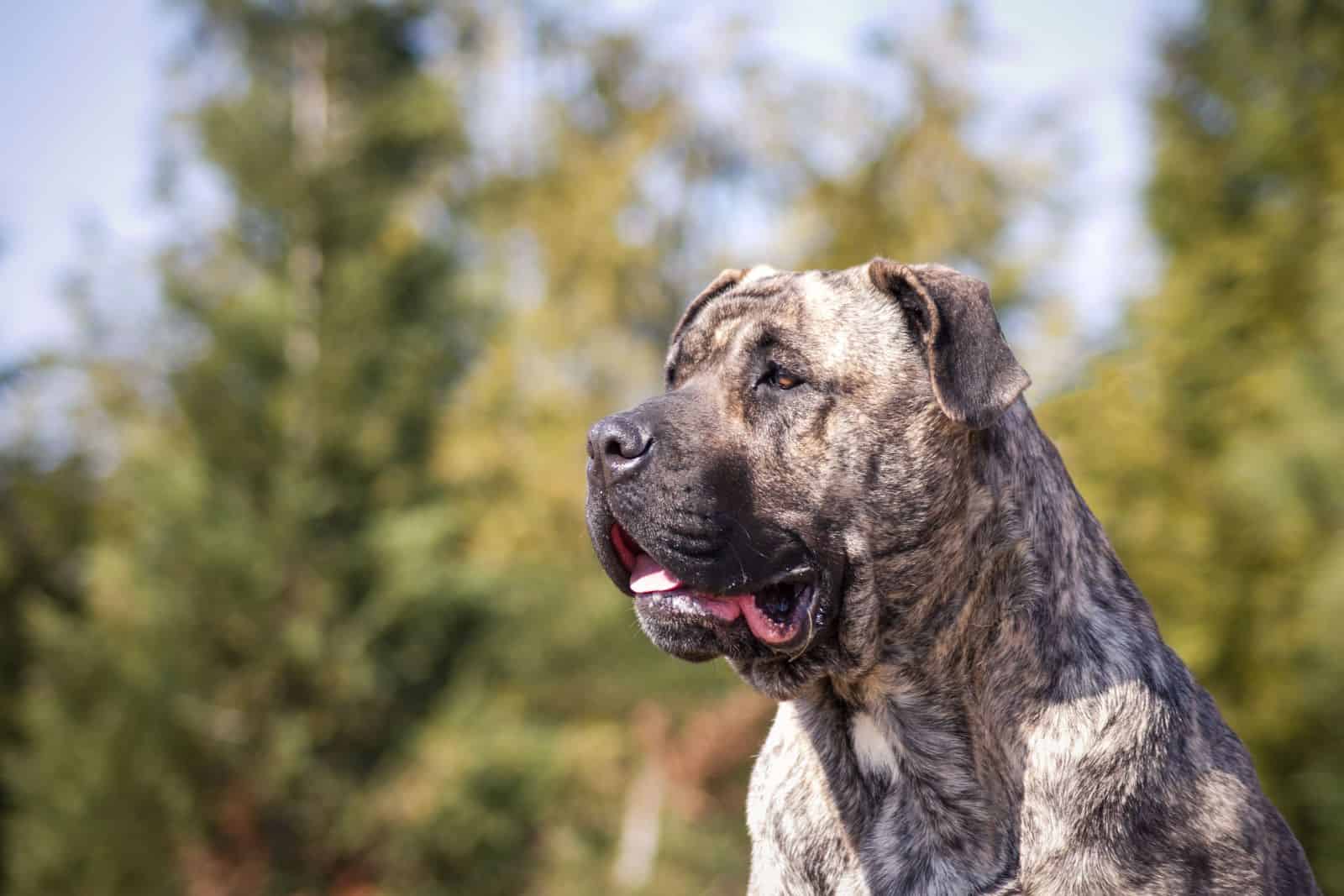
Do you like all the Perro de Presa Canario colors? Did you know all of this information? I must admit that I had a clue, but I have also learned a few facts that are new to me.
This beautiful and big dog often has a reputation of being a dangerous breed. But, just as any other breed, he can be docile and mannered if treated right, and if he had early socialization and a trainer who knew what he was doing.
And, not to mention that every dog in the end becomes a family member.
Indeed, he is a breathtaking canine, and his unique set of colors just adds to his beauty. These brindle patterns make every dog a special pooch, and it is a beautiful way to express the uniqueness of each pup.
I hope that we will learn to appreciate the importance and magnificence of this breed, and be wise enough not to let it come to the edge of existence again.
It would be such a shame to lose an impressive creature like this because of some foolish mistake. We must learn to cherish every living creature and preserve it for future generations.
It would be a shame if our children don’t get to see the splendid beauty of the Perro de Presa Canario colors.
READ NEXT:
Great Pyrenees Colors: The Truth About The White Mountain Dog
